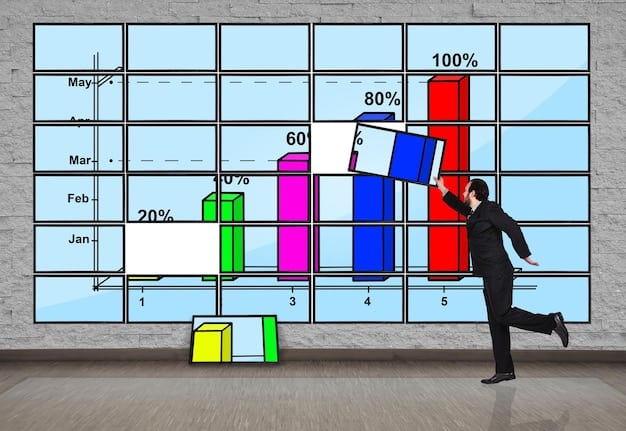Independent Films vs Blockbusters: Market Share Report 2025

In 2025, independent films are progressively capturing a larger share of the market, challenging the dominance of blockbusters through unique storytelling, niche targeting, and strategic digital distribution.
Are independent films gaining ground on blockbusters? A 2025 market share report suggests a notable shift within the film industry, prompting questions about the evolving preferences of audiences and the strategies employed by independent filmmakers.
The Rise of Indie Cinema: A 2025 Snapshot
Independent films are experiencing a resurgence, captivating audiences with their unique narratives and artistic vision. This section delves into the current state of the industry, assessing the factors driving the increased popularity of indie cinema in 2025.
What are the key trends that define the landscape of independent film in 2025? How are these films reshaping the film industry, and why are they becoming more appealing to a broader audience?
The Streaming Effect
Streaming platforms have democratized access to independent films, allowing them to reach wider audiences without the traditional gatekeepers.
Audience Appetite for Authenticity
Audiences are increasingly seeking out authentic stories and diverse perspectives, which indie films often deliver with greater nuance and depth.
- Increased visibility through streaming services has propelled independent films into mainstream conversations.
- Niche audiences are finding content that speaks directly to their interests, bypassing the need for mass appeal.
- Lower production costs compared to blockbusters allow for greater creative risks and experimental narratives.
- Word-of-mouth marketing and social media engagement play a crucial role in driving viewership for indie films.
As independent films continue to innovate and connect with viewers on a personal level, their influence on the overall film market will likely expand, contributing to a more diverse and vibrant cinematic ecosystem. The confluence of these factors paints a promising picture for the future of independent filmmaking.

Blockbusters in Decline? Analyzing the Major Studio Slump
While independent films rise, are blockbusters faltering? This section scrutinizes the performance of major studio releases, identifying potential weaknesses and shifts in audience behavior that contribute to a perceived decline in blockbuster dominance.
Why are some blockbusters underperforming at the box office? What strategies can major studios adopt to recapture audience interest and ensure the continued success of their tentpole releases?
Franchise Fatigue
Audiences may be experiencing “franchise fatigue,” growing tired of endless sequels, reboots, and cinematic universes with formulaic storytelling.
High Ticket Prices and Overall Costs
The rising cost of movie tickets and concessions can deter families and casual viewers from seeing blockbusters in theaters, especially when alternative entertainment options are readily available.
- Over-reliance on CGI and special effects can overshadow compelling characters and meaningful narratives.
- Lack of originality and risk aversion in script development has led to predictable and uninspired storylines.
- Poor marketing campaigns that fail to generate genuine excitement can result in disappointing box office returns.
- Competition from streaming platforms offering high-quality original content poses a significant threat to traditional blockbuster viewership.
Navigating these challenges will require embracing innovation, prioritizing quality over quantity, and re-evaluating the relationship between studios and their audiences. Understanding this shift from the audience is key to any studios next steps.
The Economic Impact: Indie vs. Blockbuster Budgets
The financial dynamics of independent films and blockbusters differ significantly, impacting their production, marketing, and distribution strategies. This section explores the economic contrasts between these two segments of the film industry, examining the advantages and limitations of each model.
How do smaller budgets impact the creative freedom of independent filmmakers? Conversely, how do massive marketing budgets influence the success of blockbuster releases?
Creative Freedom vs. Marketability
Independent filmmakers often enjoy greater creative freedom due to their smaller budgets and lack of studio interference, allowing them to take risks and experiment with unconventional storytelling.
Grassroots Marketing vs. Extensive Advertising
Independent films rely on grassroots marketing efforts, such as film festival screenings and social media campaigns, to generate buzz and reach their target audiences, while blockbusters employ extensive advertising campaigns across various media channels.

Exploring these economic discrepancies sheds light on the diverse approaches to filmmaking and the varying degrees of financial risk and reward associated with each segment of the industry.
Distribution Revolution: Streaming and Beyond
The traditional model of theatrical distribution is evolving rapidly, with streaming platforms playing an increasingly prominent role in connecting films with audiences. Independent films, in particular, are benefiting from these changes, gaining access to wider distribution channels and bypassing the limitations of traditional cinema releases.
How are streaming platforms reshaping the distribution landscape for independent films? What innovative strategies are indie filmmakers using to reach audiences beyond traditional theatrical releases?
Direct-to-Streaming Releases
Many independent films are opting for direct-to-streaming releases, bypassing theaters altogether and reaching audiences directly in their homes.
Hybrid Distribution Models
Some indie filmmakers are embracing hybrid distribution models, combining limited theatrical releases with streaming availability to maximize their reach and generate revenue from multiple sources.
- The rise of virtual cinema platforms has created new opportunities for independent films to replicate the theatrical experience online.
- Film festivals are increasingly partnering with streaming services to showcase independent films to a global audience.
- Social media and online communities play a crucial role in driving awareness and viewership for indie films on streaming platforms.
- Data analytics and targeted advertising allow indie filmmakers to reach specific demographics and niche audiences with greater precision.
As distribution models continue to evolve, independent filmmakers will need to adapt and experiment with new strategies to thrive in an increasingly competitive and dynamic landscape.
Audience Shifting: Who’s Watching Indie Films in 2025?
Understanding the demographics and preferences of audiences who watch independent films is crucial for filmmakers and distributors alike. This section examines the shifting audience landscape, identifying the key characteristics and motivations of viewers who are drawn to indie cinema in 2025.
What are the demographic trends that define the audience for independent films? What motivates viewers to seek out indie cinema over mainstream blockbusters?
Young Adults and Gen Z
Young adults and Gen Z are increasingly embracing independent films, drawn to their authentic storytelling, diverse perspectives, and social relevance.
Niche Communities and Interest Groups
Independent films often cater to niche communities and interest groups, attracting viewers who are passionate about specific topics, genres, or cultural identities.
- Audiences are seeking out films that reflect their own experiences and values, leading them to embrace independent cinema.
- The desire for unique and thought-provoking content is driving viewers away from formulaic blockbusters and towards indie films.
- Word-of-mouth recommendations and social media buzz play a significant role in influencing audience choices.
- The accessibility of independent films on streaming platforms has made it easier for audiences to discover and explore indie cinema.
By understanding the needs and desires of their target audiences, independent filmmakers can tailor their marketing efforts and create films that resonate deeply with viewers. This will not only engage with younger and more unique crowds, but also lead to an increase in revenue from them.
Predictions for the Future: Indie Film Market Share in 2030
Looking ahead to the future, what are the potential scenarios for the independent film market share in 2030? This section offers predictions and insights based on current trends, technological advancements, and evolving audience preferences, painting a picture of the opportunities and challenges that lie ahead for indie cinema.
How will streaming platforms continue to impact the distribution and consumption of independent films? What role will virtual reality and immersive experiences play in the future of indie cinema?
Continued Growth and Expansion
The independent film market share is projected to continue growing in the coming years, driven by the factors discussed throughout this report.
Increased Competition and Consolidation
As the independent film market becomes more lucrative, increased competition and consolidation are likely, with larger studios and streaming services acquiring independent production companies and distributors.
- Technological advancements, such as virtual reality and augmented reality, could create new opportunities for independent filmmakers to experiment with immersive storytelling.
- The rise of personalized content recommendations and AI-powered curation could make it easier for audiences to discover independent films that align with their interests.
- The development of new funding models, such as crowdfunding and blockchain-based financing, could empower independent filmmakers to retain greater control over their projects.
- The ongoing evolution of distribution models, including direct-to-fan platforms and community-based screenings, could foster closer relationships between filmmakers and their audiences.
Navigating these changes will require adaptability, resilience, and a commitment to innovation. Independent filmmakers who embrace new technologies, experiment with new storytelling techniques, and build strong relationships with their audiences will be best positioned to thrive in the ever-evolving world of cinema.
| Key Point | Brief Description |
|---|---|
| 🎬 Indie Film Rise | Gaining popularity through unique storytelling. |
| 📉 Blockbuster Slump | Facing challenges like franchise fatigue. |
| 🌐 Distribution | Streaming revolutionizes film access. |
| 🎯 Audience Shift | Younger audiences prefer indie authenticity. |
Frequently Asked Questions
▼
Independent films are produced outside the major studio system, typically with smaller budgets and greater creative control for the filmmakers. They often explore niche themes.
▼
Audiences crave authenticity and diverse storytelling, which independent films often deliver. Streaming platforms also provide greater accessibility to these films.
▼
Independent films often struggle with limited marketing budgets and distribution challenges compared to major studio blockbusters. Funding can also be precarious.
▼
Streaming services provide a platform for independent films to reach a wider audience, increasing visibility and potential revenue streams that bypass traditional theatrical releases.
▼
“Franchise fatigue” refers to audience weariness with endless sequels and reboots. This trend can lead to underperformance of some blockbusters at the box office.
Conclusion
The film industry in 2025 is marked by a dynamic interplay between independent films and blockbusters. As indie cinema continues to gain ground, driven by audience demand for authentic and diverse stories, major studios face the challenge of adapting to evolving preferences. The future of film promises innovation, competition, and a richer cinematic experience for viewers.





